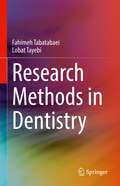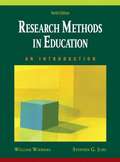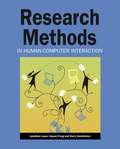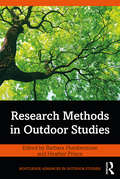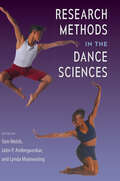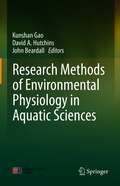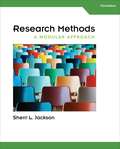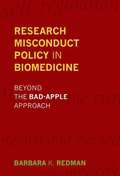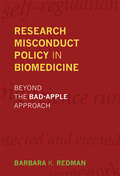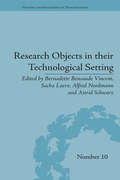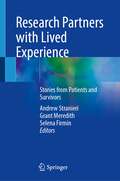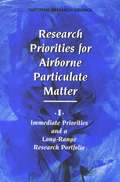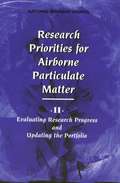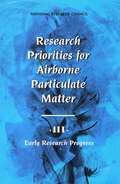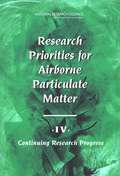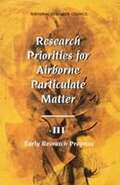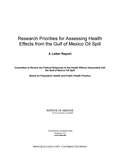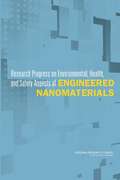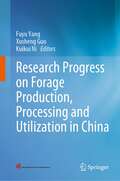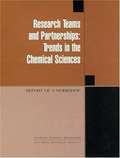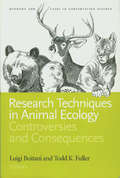- Table View
- List View
Research Methods in Dentistry
by Lobat Tayebi Fahimeh TabatabaeiThis classroom-tested textbook will assist dental students with their academic research activities and help them to be competitive in today’s fast-growing research environment. It is designed as a core text for dental school classes such as Research Methodology and Scientific and Technical Writing, as well as Responsible Conduct of Research (RCR) training, but will also be a valuable resource for students and researchers in related fields, such as the medical sciences and biomedical engineering. The authors start the book by explaining key concepts and common approaches in dental research, both in basic science and clinical dentistry. They then familiarize readers with evidence-based research in dentistry and how to write a systematic review, explain the process of designing and presenting a proposal, discuss reporting results both in scientific and clinical research, and cover ethics in research, highlighting the significance of adherence to ethics both in animal as well as human studies.
Research Methods in Education: An Introduction (9th Edition)
by William Wiersma Stephen G. JursA classic in its field, Research Methods in Education explains the research process with emphasis on the formulation of a research question, referencing current literature in the field, using appropriate research designs, and writing and evaluating research reports. Both quantitative and qualitative research designs are described. Measurement, sampling, and statistics are presented as essential research tools. Retaining the clear, concise writing style and organization that has made this text so popular,Research Methods in Education helps students evaluate research literature as well as master research methodology. It emphasizes the rationale for commonly used research procedures and their applications. The authors outline the nature of educational research and clearly define the steps in the research process. The text is broad in scope-covering both quantitative, qualitative and mixed methods research methodologies as well as describing how to write research proposals and reports of completed research. Research Methods in Education gives students a solid understanding of all the elements of research.
Research Methods in Human-computer Interaction
by Jonathan Lazar Harry Hochheiser Jinjuan Heidi FengA comprehensive research guide for both quantitative and qualitative research methods Written by a team of authorities in human-computer interaction (HCI) and usability, this pedagogical guide walks you through the methods used in HCI and examines what are considered to be appropriate research practices in the field. Featuring a plethora of real-world examples throughout, you'll discover how these methods have been used in HCI research so that you can gain a stronger understanding of the subject matter. Serves as an authoritative, comprehensive resource on all things related to research methods in human-computer interaction Addresses experimental research and design methods, statistical analysis, and time diaries Shares authentic case studies, interviews, and focus group experiences Reviews analyzing qualitative data, working with human subjects, handling automated computer data collection methods, and more If you are looking for a detailed, no-nonsense resource that offers in-depth coverage of HCI methods, then this is the book for you.
Research Methods in Outdoor Studies (Routledge Advances in Outdoor Studies)
by Barbara Humberstone Heather PrinceOver the last two decades Outdoor Studies has emerged as an innovative and vibrant field of study. This is the first book to offer a comprehensive appraisal of established and cutting-edge research methods as applied to Outdoor Studies. Covering qualitative, quantitative and mixed methods, the book examines key methodologies, themes and technologies such as digital research, mobile methodologies, ethnography, interviews, research design, research ethics and ways of disseminating research. Featuring contributions from leading researchers from a variety of disciplinary backgrounds, this is an essential text for any Outdoor Studies course or for researchers looking for innovative and creative research techniques.
Research Methods in Social Relations (7th edition)
by Rick H. Hoyle Monica J. Harris Charles M. JuddA problem-focused perspective to social science methods.
Research Methods in the Dance Sciences
by Tom Welsh, Jatin P. Ambegaonkar, and Lynda MainwaringA comprehensive guide to conducting empirical research in dance Research Methods in the Dance Sciences introduces concepts and practices that support effective, empirical research in the dance sciences, including medical science. A valuable new resource for this growing field, this book provides foundational knowledge for anyone who wants to understand, apply, and conduct research with dancers and proposes ways to facilitate more collaboration between the many disciplines that often overlap in this area.In this volume, pioneers of dance medicine and science guide readers through the stages of the research process. They address topics such as choosing a research question, writing a literature review, developing a framework and methodology, influencing the field, and progressing in a research career. Offering dance-specific examples as illustrations, this volume provides clear and instructive strategies for developing a solid repertoire of research skills to examine dance and movement-centered activities. It is ideal for practicing and aspiring dancers, teachers, and clinicians in fields including exercise physiology, motor learning, behavioral sciences, food sciences, medicine, psychology, and somatics who are interested in dance science research.
Research Methods in the Social Sciences (Seventh Edition)
by Chava Frankfort-Nachmias David NachmiasResearch Methods in the Social Sciences offer a comprehensive, systematic presentation of the scientific approach within the context of the social sciences. The text, together with the supporting materials, will help readers move through the major stages of the research process.
Research Methods of Environmental Physiology in Aquatic Sciences
by John Beardall Kunshan Gao David A. HutchinsThis book presents methods for investigating the effects of aquatic environmental changes on organisms and the mechanisms involved. It focuses mainly on photosynthetic organisms, but also provides methods for virus, zooplankton and other animal studies. Also including a comprehensive overview of the current methods in the fields of aquatic physiology, ecology, biochemistry and molecular approaches, including the advantages and disadvantages of each method, the book is a valuable guide for young researchers in marine or aquatic sciences studying the physiological processes associated with chemical and physical environmental changes.
Research Methods: A Modular Approach (Third Edition )
by Sherri L. JacksonThis text provides students and instructors, a simple approach to learning and teaching research methods, concisely yet comprehensively. The text is organized into 10 chapters, each divided into modules. The modular format allows students to digest smaller chunks and allows teachers to enjoy greater flexibility in reading assignments and class coverage.
Research Misconduct Policy in Biomedicine
by Barbara K. RedmanFederal regulations that govern research misconduct in biomedicine have not been able to prevent an ongoing series of high-profile cases of fabricating, falsifying, or plagiarizing scientific research. In this book, Barbara Redman looks critically at current research misconduct policy and proposes a new approach that emphasizes institutional context and improved oversight. Current policy attempts to control risk at the individual level. But Redman argues that a fair and effective policy must reflect the context in which the behavior in question is embedded. As journalists who covered many research misconduct cases observed, the roots of fraud "lie in the barrel, not in the bad apples that occasionally roll into view." Drawing on literature in related fields -- including moral psychology, the policy sciences, the organizational sciences, and law -- as well as analyses of misconduct cases, Redman considers research misconduct from various perspectives. She also examines in detail a series of clinical research cases in which repeated misconduct went undetected and finds laxity of oversight, little attention to harm done, and inadequate correction of the scientific record. Study questions enhance the book's value for graduate and professional courses in research ethics.Redman argues that the goals of any research misconduct policy should be to protect scientific capital (knowledge, scientists, institutions, norms of science), support fair competition, contain harms to end users and to the public trust, and enable science to meet its societal obligations.
Research Misconduct Policy in Biomedicine: Beyond the Bad-Apple Approach (Basic Bioethics)
by Barbara K. RedmanAn analysis of current biomedical research misconduct policy that proposes a new approach emphasizing the context of misconduct and improved oversight.Federal regulations that govern research misconduct in biomedicine have not been able to prevent an ongoing series of high-profile cases of fabricating, falsifying, or plagiarizing scientific research. In this book, Barbara Redman looks critically at current research misconduct policy and proposes a new approach that emphasizes institutional context and improved oversight. Current policy attempts to control risk at the individual level. But Redman argues that a fair and effective policy must reflect the context in which the behavior in question is embedded. As journalists who covered many research misconduct cases observed, the roots of fraud “lie in the barrel, not in the bad apples that occasionally roll into view.” Drawing on literature in related fields—including moral psychology, the policy sciences, the organizational sciences, and law—as well as analyses of misconduct cases, Redman considers research misconduct from various perspectives. She also examines in detail a series of clinical research cases in which repeated misconduct went undetected and finds laxity of oversight, little attention to harm done, and inadequate correction of the scientific record. Study questions enhance the book's value for graduate and professional courses in research ethics.Redman argues that the goals of any research misconduct policy should be to protect scientific capital (knowledge, scientists, institutions, norms of science), support fair competition, contain harms to end users and to the public trust, and enable science to meet its societal obligations.
Research Objects in their Technological Setting (History and Philosophy of Technoscience)
by Alfred Nordmann Astrid Schwarz Sacha Loeve Bernadette Bensaude VincentWhat kind of stuff is the world made of? What is the nature or substance of things? These are ontological questions, and they are usually answered with respect to the objects of science. The objects of technoscience tell a different story that concerns the power, promise and potential of things – not what they are but what they can be. Seventeen scholars from history and philosophy of science, epistemology, social anthropology, cultural studies and ethics each explore a research object in its technological setting, ranging from carbon to cardboard, from arctic ice cores to nuclear waste, from wetlands to GMO seeds, from fuel cells to the great Pacific garbage patch. Together they offer fascinating stories and novel analytic concepts, all the while opening up a space for reflecting on the specific character of technoscientific objects. With their promise of sustainable innovation and a technologically transformed future, these objects are highly charged with values and design expectations. By clarifying their mode of existence, we are learning to come to terms more generally with the furniture of the technoscientific world – where, for example, the 'dead matter' of classical physics is becoming the 'smart material' of emerging and converging technologies.
Research Partners with Lived Experience: Stories from Patients and Survivors
by Andrew Stranieri Grant Meredith Selena FirminThis book aims to foster collaborations between patients who have intense lived experience with a medical condition or family violence and researchers investigating them. Inviting patients or survivors into the research team is found to have significant advantages, and chapters review the literature on the benefits they can bring to investigative research teams. The collaboration can take place at multiple stages of research from helping to research design, participating in co-investigators, contributing to the interpretation of results, etc. The conditions addressed in this book include medical conditions from anxiety, postural orthostatic tachycardia syndrome, lupus, asthma, chronic kidney disease, etc. The authors are higher degree students, academics, and active research team members who share their experiences. This is be instrumental in helping patients and survivors decide whether to transition to research. It will also support research team leaders in determining how to benefit from the new perspectives researchers with lived experience bring. The personal narratives provide insight into the challenges and rewards of having lived experience while conducting research. This book is a valuable resource for researchers in clinical fields who have been touched by firsthand exposure to a condition and have been motivated to conduct research in the respective fields. The chapters will enrich understanding for adult patients and survivors and for parents of children suffering intense experiences, who engage with the latest research publications. It will also broaden the understanding of medical, biomedical, and health sciences students interested in reading the narrative accounts of patients and survivors. Readers will gain refreshing perspectives and insights. The book relates to patients managing all kinds of noncommunicable diseases or experiences of violence, and how they can share their valuable experiences into future advancementto research. It is related to SDG 3, good health and well-being.
Research Priorities for Airborne Particulate Matter, Volume I: Immediate Priorities and a Long-Range Research Portfolio
by Committee on Research Priorities for Airborne Particulate MatterNew National Ambient Air Quality Standards for airborne particles smaller than 2.5 micrometers, called PM2.5, were issued by the U.S. Environmental Protection Agency (EPA) amidst scientific uncertainty and controversy. In response to a request from Congress, Research Priorities for Airborne Particulate Matter, the first of four books in a series, offers a conceptual framework for an integrated national program of particulate-matter research, identifies the 10 most critical research needs linked to key policy-related scientific uncertainties, and describes the recommended timing and estimated costs of such research.The committee concludes that EPA should devote more resources to investigating the relationships between fixed-site outdoor monitoring data and actual human breathing-zone exposures to ambient particulate matter and to identifying the most biologically important constituents and characteristics of particulate matter through toxicological studies. The recommended research activities are critical to determining actual exposures of human subpopulations most susceptible to harm from the most hazardous constituents of particulate matter. Future research will be an investment in public health and a means to ensure that resources spent on control technology and regulatory compliance will have a reasonable probability of success.
Research Priorities for Airborne Particulate Matter, Volume II
by Committee on Research Priorities for Airborne Particulate MatterIn the effort to reduce the scientific and technical uncertainties over regulation of airborne particulate matter in the United States, Research Priorities for Airborne Particulate Matter: II. Evaluating Research Progress and Updating the Portfolio, the second book in a four-part series requested by Congress, describes the plans of the committee to monitor the progress of the research on particulate matter conducted by the U.S. Environmental Protection Agency (EPA), other federal and state government agencies, and nongovernmental organizations.The book also reviews and updates the committee's portfolio of recommended research in its first volume, Research Priorities for Airborne Particulate Matter: I. Immediate Priorities and a Long-Range Research Portfolio (NRC, 1998). The committee substantially revised two of the ten high-priority research areas recommended in Part I. Part II notes that Congress, EPA, and the scientific community have given strong support to the committee's recommendations and have implemented substantial changes in research efforts in response to Part I of the series. One important research area-studies of the effects of long-term exposure to particulate matter and other major air pollutants-however, does not appear to be underway or planned.
Research Priorities for Airborne Particulate Matter, Volume III
by Committee on Research Priorities for Airborne Particulate MatterRegulatory standards are already on the books at the the U.S. Environmental Protection Agency (EPA) to address health risks posed by inhaling tiny particles from smoke, vehicle exhaust, and other sources. At the same time, Congress and EPA have initiated a multimillion dollar research effort to better understand the sources of these airborne particles, the levels of exposure to people, and the ways that these particles cause damage. To provide independent guidance to the EPA, Congress asked the National Research Council to study the relevant issues. The result is a series of four reports on the particulate-matter research program. The first two books offered a conceptual framework for a national research program, identified the 10 most critical research needs, and described the recommended timing and estimated costs of such research. This, the third volume, begins the task of assessing the progress made in implementing the research program. The National Research Council ultimately concludes that the ongoing program is appropriately addressing many of the key uncertainties. However, it also identifies a number of critical specific subjects that should be given greater attention. Research Priorities for Airborne Particulate Matter focuses on the most current and planned research projects with an eye toward the fourth and final report, which will contain an updated assessment.
Research Priorities for Airborne Particulate Matter, Volume IV
by Committee on Research Priorities for Airborne Particulate MatterIn 1997, the U. S. Environmental Protection Agency (EPA) established regulatory standards to address health risks posed by inhaling tiny particles from smoke, vehicle exhaust, and other sources. At the same time, Congress and the EPA began a multimillion dollar research effort to better understand the sources of these airborne particles, the levels of exposure to people, and the ways that these particles cause disease. To provide independent guidance to the EPA, Congress asked the National Research Council to study the relevant issues. The result was a series of four reports on the particulate-matter research program. The first two books offered a conceptual framework for a national research program, identified the 10 most critical research needs, and described the recommended timing and estimated costs of such research. The third volume began the task of assessing initial progress made in implementing the research program. This, the fourth and final volume, gauged research progress made over a 5-year period on each of the 10 research topics. The National Research Council concludes that particulate matter research has led to a better understanding of the health effects caused by tiny airborne particles. However, the EPA, in concert with other agencies, should continue research to reduce further uncertainties and inform long-term decisions.
Research Priorities for Airborne Particulate Matter: * III *
by National Research CouncilRegulatory standards are already on the books at the the U.S. Environmental Protection Agency (EPA) to address health risks posed by inhaling tiny particles from smoke, vehicle exhaust, and other sources. At the same time, Congress and EPA have initiated a multimillion dollar research effort to better understand the sources of these airborne particles, the levels of exposure to people, and the ways that these particles cause damage. To provide independent guidance to the EPA, Congress asked the National Research Council to study the relevant issues. The result is a series of four reports on the particulate-matter research program. The first two books offered a conceptual framework for a national research program, identified the 10 most critical research needs, and described the recommended timing and estimated costs of such research. This, the third volume, begins the task of assessing the progress made in implementing the research program. The National Research Council ultimately concludes that the ongoing program is appropriately addressing many of the key uncertainties. However, it also identifies a number of critical specific subjects that should be given greater attention. Research Priorities for Airborne Particulate Matter focuses on the most current and planned research projects with an eye toward the fourth and final report, which will contain an updated assessment.
Research Priorities for Airborne Particulate Matter: I Immediate Priorities and a Long-Range Research Portfolio
by Committee on Research Priorities for Airborne Particulate MatterNew National Ambient Air Quality Standards for airborne particles smaller than 2.5 micrometers, called PM2.5, were issued by the U.S. Environmental Protection Agency (EPA) amidst scientific uncertainty and controversy. In response to a request from Congress, Research Priorities for Airborne Particulate Matter, the first of four books in a series, offers a conceptual framework for an integrated national program of particulate-matter research, identifies the 10 most critical research needs linked to key policy-related scientific uncertainties, and describes the recommended timing and estimated costs of such research.The committee concludes that EPA should devote more resources to investigating the relationships between fixed-site outdoor monitoring data and actual human breathing-zone exposures to ambient particulate matter and to identifying the most biologically important constituents and characteristics of particulate matter through toxicological studies. The recommended research activities are critical to determining actual exposures of human subpopulations most susceptible to harm from the most hazardous constituents of particulate matter. Future research will be an investment in public health and a means to ensure that resources spent on control technology and regulatory compliance will have a reasonable probability of success.
Research Priorities for Assessing Health Effects from the Gulf of Mexico Oil Spill: A Letter Report
by Institute of MedicineIt is as yet uncertain how the Gulf of Mexico oil spill will affect the health of clean-up workers and volunteers, residents, and visitors in the Gulf. The IOM recommends that the U.S. Department of Health and Human Services focus on researching psychological and behavioral health, exposure information to oil and dispersants, seafood safety, communication methods for health studies, and methods for conducting research in order to better understand and mitigate the effects on human health for this oil spill and for future disasters.
Research Progress in Oligosaccharins
by Heng Yin Yuguang Du"Research Progress in Oligosaccharins" is a valuable tool for students and researchers who want to learn about this unique class of bioactive compounds. This book provides important insight into the complex roles of oligosaccharins in plant immunity, physiology, and protection. Oligosaccharins are complex carbohydrates that function in plants as molecular signals to regulate growth, development, and stress resistance. Based on the rapid development of glycobiology and molecular biology, a great deal of research work focused on oligosaccharins has been carried out in the last thirty years. As a result, several different oligosaccharins such as chitosan oligosaccharides, chitin oligosaccharides, glucan oligosaccharides, alginate oligosaccharides have been identified and their mechanisms of actions studied. Although major recent advancements have been made, there isn't an up-to-date systemic overview on the topic. Our objective is therefore to create a work that informs the reader of the nature of oligosaccharins, the different kinds of oligosaccharins, their functions and the mechanism of oligosaccharins-plants interaction.
Research Progress on Environmental, Health, and Safety Aspects of Engineered Nanomaterials
by Toxicology Committee to Develop a Research Strategy for Environmental StudiesDespite the increase in funding for research and the rising numbers of peer-reviewed publications over the past decade that address the environmental, health, and safety aspects of engineered nanomaterials (ENMs), uncertainty about the implications of potential exposures of consumers, workers, and ecosystems to these materials persists. Consumers and workers want to know which of these materials they are exposed to and whether the materials can harm them. Industry is concerned about being able to predict with sufficient certainty whether products that it makes and markets will pose any environmental, health or safety issues and what measures should be taken regarding manufacturing practices and worldwide distribution to minimize any potential risk. However, there remains a disconnect between the research that is being carried out and its relevance to and use by decision-makers and regulators to make informed public health and environmental policy and regulatory decisions. "Research Progress on Environmental, Health, and Safety Aspects of Nanomaterials" evaluates research progress and updates research priorities and resource estimates on the basis of results of studies and emerging trends in the nanotechnology industry. This report follows up the 2012 report "A Research Strategy for Environmental, Health, and Safety Aspects of Engineered Nanomaterials," which presented a strategic approach for developing the science and research infrastructure needed to address uncertainties regarding the potential environmental, health, and safety risks posed by ENMs. This new report looks at the state of nanotechnology research, examines market and regulatory conditions and their affect on research priorities, and considers the criteria for evaluating research progress on the environmental, health, and safety aspects of nanotechnology.
Research Progress on Forage Production, Processing and Utilization in China
by Fuyu Yang Xusheng Guo Kuikui NiThis book has 11 chapters which systematically introduce the latest achievements in scientific research and technological application of the forage industry in China, and also cover the laws and polices related to forage production. The main focus of this monograph is the progress of forage science in China. Each chapter in this book contains numerous charts and diagrams further illustrating the impact of development activities in the area. It is the first book in its field and compiled by mobilizing all the research forces in the field of forage grass and under the leadership of China Agricultural University, Lanzhou University, and Sichuan Academy of Grassland Sciences with the support of other related universities and research institutes. China is the largest forage consumption country in the world. Every year, more than 2 billion herbivorous livestock need more than 350 million tons of forage but the supply each year is only 250 million tons. With the policy and financial support of the Central Government, the forage industry in China has been developed rapidly, great progress has been made in the science and technology in forage production, processing, and utilization, and its influence has been increased in the world.
Research Teams and Partnerships: Report of a Workshop
by Chemical Sciences RoundtableA report on the Trends in the Chemical Sciences
Research Techniques in Animal Ecology: Controversies and Consequences (Issues, Cases, and Methods in Biodiversity Conservation)
by Todd Fuller Luigi BoitaniThe present biodiversity crisis is rife with opportunities to make important conservation decisions; however, the misuse or misapplication of the methods and techniques of animal ecology can have serious consequences for the survival of species. Still, there have been relatively few critical reviews of methodology in the field. This book provides an analysis of some of the most frequently used research techniques in animal ecology, identifying their limitations and misuses, as well as possible solutions to avoid such pitfalls. In the process, contributors to this volume present new perspectives on the collection, analysis, and interpretation of data.Research Techniques in Animal Ecology is an overarching account of central theoretical and methodological controversies in the field, rather than a handbook on the minutiae of techniques. The editors have forged comprehensive presentations of key topics in animal ecology, such as territory and home range estimates, habitation evaluation, population viability analysis, GIS mapping, and measuring the dynamics of societies. Striking a careful balance, each chapter begins by assessing the shortcomings and misapplications of the techniques in question, followed by a thorough review of the current literature, and concluding with possible solutions and suggested guidelines for more robust investigations.
